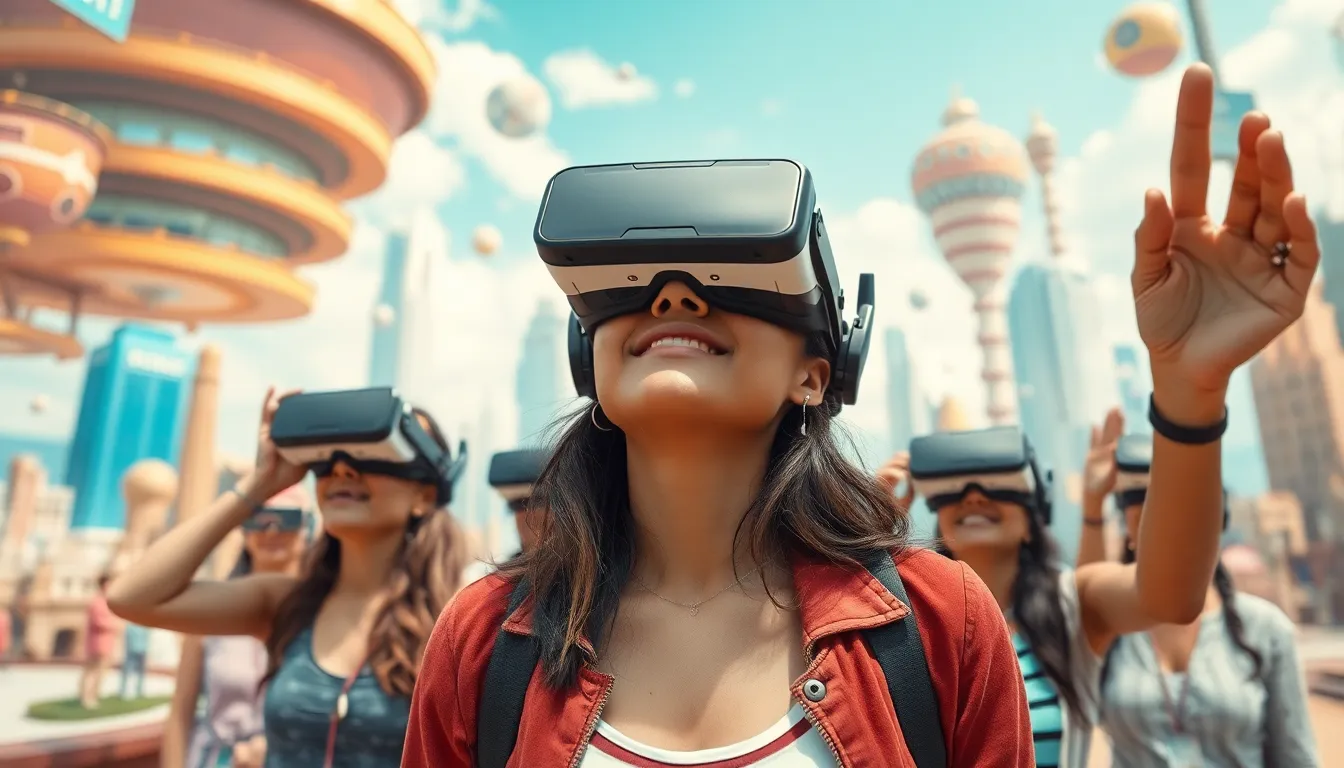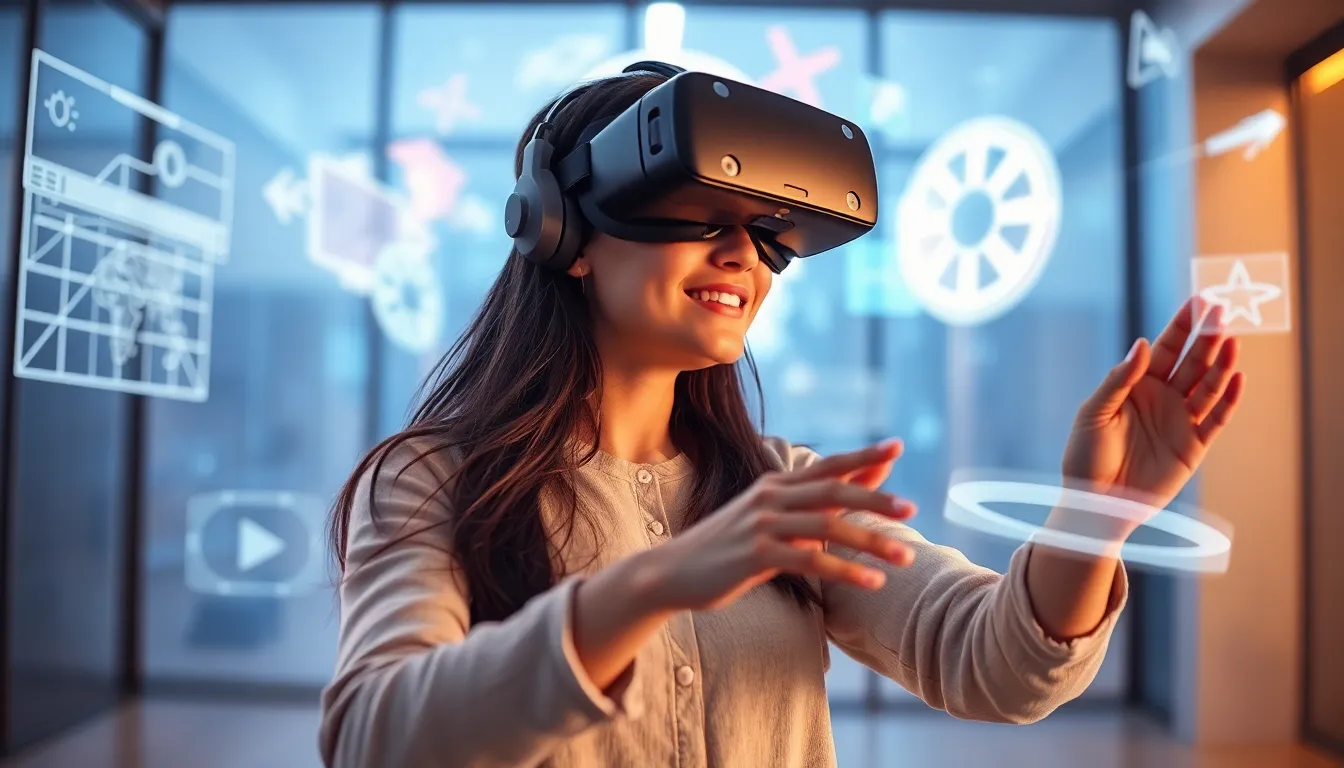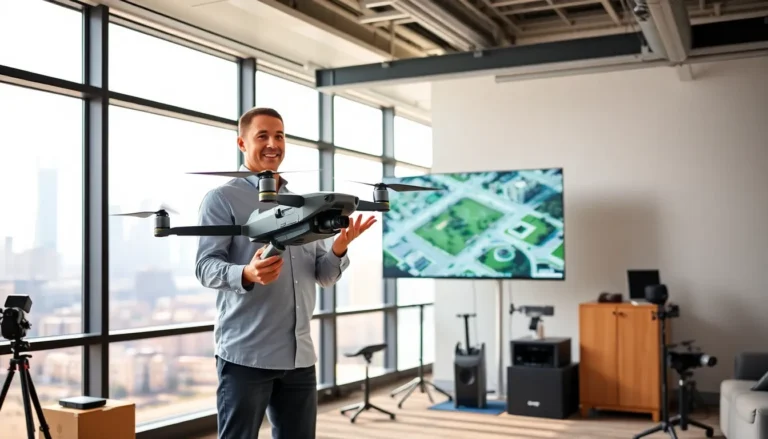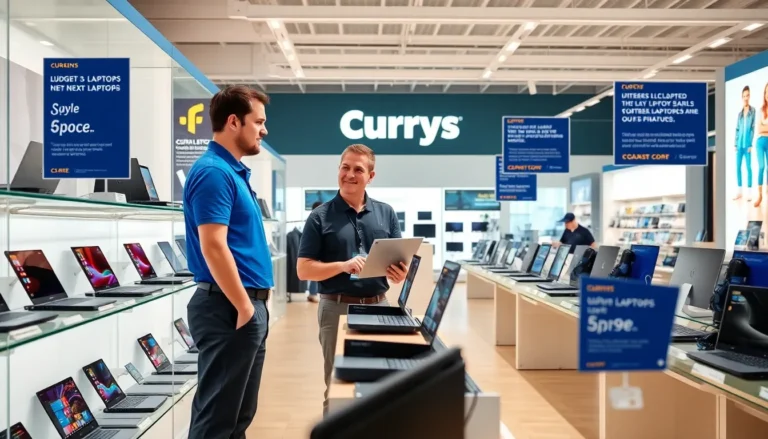Imagine stepping into a world where reality bends and your wildest dreams come to life. That’s the magic of immersive tech. From virtual reality headsets that transport users to fantastical realms to augmented reality apps that make everyday life feel like a video game, this technology isn’t just for gamers anymore. It’s revolutionizing industries, education, and even how we socialize.
As immersive tech continues to evolve, it’s reshaping how people interact with the digital world. Forget about mundane screens; this is about diving headfirst into experiences that engage the senses and spark creativity. Whether it’s exploring distant planets or learning through interactive simulations, the possibilities are endless. Buckle up as we delve into the captivating universe of immersive technology and discover how it’s changing the game for everyone.
Table of Contents
ToggleOverview of Immersive Tech
Immersive technology encompasses a range of tools designed to enhance user experiences by merging digital content with the physical world. Virtual reality (VR) transports users into entirely different environments, fostering a deep sense of presence. Augmented reality (AR) overlays digital information onto the real world, enriching interactions with contextually relevant data.
Industries increasingly adopt immersive tech to drive innovation. Education sectors utilize VR for simulations that allow students to engage interactively with complex subjects, enhancing comprehension. In healthcare, medical professionals employ AR for surgical training, offering visual aids that improve accuracy during procedures.
User engagement reaches new heights with immersive tech. Businesses leverage these technologies to create memorable marketing campaigns that captivate audiences. Many entertainment venues integrate VR experiences to offer unique attractions that draw visitors and elevate their overall experience.
Research indicates that immersive technology fosters creativity and collaboration. Teams engage in brainstorming sessions using VR environments that encourage dynamic interaction, leading to enhanced idea generation. Social applications also flourish, as individuals connect in shared virtual spaces, building communities that transcend geographic limitations.
Data suggests that the global immersive tech market is expanding rapidly. Analysts project a compound annual growth rate of over 30% from 2021 to 2026, highlighting the significance of this technology in shaping future interactions across various domains. As immersive tech continues to evolve, its multifaceted applications are set to redefine norms in communication, education, and entertainment.
Types of Immersive Tech

Immersive technology encompasses various forms, each offering unique experiences. Three primary types include Virtual Reality, Augmented Reality, and Mixed Reality.
Virtual Reality (VR)
Virtual Reality provides users with fully immersive environments. Headsets allow individuals to explore simulated worlds that may replicate real scenarios or create entirely imaginative landscapes. With VR, educational institutions use simulations for training purposes, helping students practice in realistic settings. Multiple industries, such as real estate, utilize VR to showcase properties through virtual tours. User engagement increases, leading to deeper understanding and retention of information in users.
Augmented Reality (AR)
Augmented Reality enhances real-world environments by overlaying digital information. This technology integrates graphics, sounds, and other virtual elements into the user’s view of the physical world. For instance, mobile apps employ AR to display informative content about landmarks or products when viewed through a device. Retailers leverage AR to enable customers to visualize how furniture looks in their homes. AR fosters interactive learning, enabling students to engage with educational content in innovative ways.
Mixed Reality (MR)
Mixed Reality blends elements from both virtual and augmented realities. Combining real and virtual worlds, MR allows users to interact with digital objects as if they exist in the physical space. This technology provides enhanced experiences in industries such as gaming, where players manipulate virtual characters within their environment. Organizations employ MR for collaborative work, enabling teams to visualize projects from different perspectives. By merging realities, MR promotes creativity and problem-solving through immersive interactions.
Applications of Immersive Tech
Immersive technology transforms various sectors through innovative applications. Significant areas include gaming, education, training, and healthcare, where these technologies enhance user experiences and efficiencies.
Gaming and Entertainment
Gaming remains a leading sector for immersive tech. Virtual reality provides players with fully immersive worlds, improving engagement and interaction. Popular titles allow users to experience new narratives in ways traditional gaming doesn’t offer. Augmented reality creates interactive gameplay by merging digital elements with the physical environment. Games like Pokémon GO exemplify this blend, allowing players to explore real-world settings while engaging with virtual creatures. Such advancements not only elevate entertainment experiences but also broaden access to diverse gaming audiences.
Education and Training
In education and training, immersive tech revolutionizes the learning process. Virtual reality facilitates interactive simulations, allowing students to practice real-world skills in a controlled environment. Medical students benefit from VR experiences that simulate surgeries, enhancing their training significantly. Additionally, augmented reality enhances textbook content by overlaying interactive visuals, reinforcing learning concepts. This technology also supports collaboration among trainees, enabling remote participation in educational experiences. Institutions increasingly adopt these technologies to foster deeper understanding and engagement.
Healthcare Innovations
Healthcare innovations leverage immersive tech to improve patient outcomes and training methods. Surgeons use augmented reality during operations, receiving real-time data overlays that enhance precision. Virtual reality aids in pain management and rehabilitation by providing immersive distraction techniques that alleviate discomfort. Medical professionals participate in realistic VR simulations to refine their skills before interacting with patients. This hands-on training improves confidence and competence in real-life scenarios. As the healthcare field continues adopting these technologies, benefits extend to patients and providers alike.
Benefits and Challenges of Immersive Tech
Immersive tech offers significant advantages and presents notable challenges. Users experience a transformation in how they interact with digital content and real-world environments.
Enhanced User Experience
Immersive technology creates engaging and interactive experiences. Users appreciate virtual reality for its ability to transport them to entirely new worlds, enhancing learning and training. Augmented reality makes everyday tasks more dynamic by overlaying helpful information onto the physical environment. Enhancements in user interaction foster creativity and collaboration, especially in educational settings, where students engage with material more deeply. Individuals using simulations retain information more effectively, leading to improved outcomes in fields like healthcare and training.
Technical Limitations
Technical challenges persist in immersive technology’s growth. High costs associated with equipment and software can deter adoption among smaller organizations. Limited battery life on devices restricts prolonged usage, making it crucial for developers to enhance power efficiency. Compatibility issues often arise, as not all software works seamlessly across various systems. Additionally, the need for powerful hardware limits accessibility for some users. Ensuring immersive experiences remain user-friendly becomes increasingly important to drive widespread acceptance.
Future Trends in Immersive Tech
Expect immersive technology to evolve significantly in the coming years. Virtual reality and augmented reality are driving this evolution, with advancements in hardware and software making experiences more seamless. Increased accessibility to high-quality VR headsets and AR applications will attract wider audiences.
Enhanced social experiences stand out as a key trend. Users will connect in shared immersive environments, fostering collaboration and creativity. These shared experiences will extend beyond gaming and move into professional settings, redefining teamwork dynamics.
Development in artificial intelligence plays a critical role in shaping immersive tech. AI integration allows for more personalized and adaptive experiences, making interactions feel more lifelike. Experiences will adjust based on user behavior, preferences, and feedback.
Healthcare applications are set to grow. As organizations adopt immersive technology for training and simulations, medical professionals will benefit from more effective learning. Innovations in AR will improve surgical precision by providing real-time data overlay.
Education will also see transformative changes. Interactive learning modules will become commonplace, with students engaging in hands-on simulations. This method enhances understanding and retention of complex subjects.
Marketing strategies will embrace immersive tech extensively. Brands will utilize AR for interactive advertising campaigns, creating memorable experiences that captivate consumers. Audience engagement will multiply as immersive storytelling techniques become mainstream.
Finally, the global market for immersive technology is projected to expand rapidly. Analysts forecast market growth exceeding a compound annual growth rate of 30% from 2021 to 2026. This shift highlights the technology’s increasing influence on everyday life and future interactions.
Immersive technology is reshaping how people interact with the world around them. Its applications span multiple sectors from education to healthcare enhancing user experiences and fostering creativity. As it continues to evolve the potential for more engaging and personalized interactions grows.
The rapid expansion of the immersive tech market signals a future where these innovations become integral to daily life. With advancements in hardware and software on the horizon the possibilities for enhancing learning training and entertainment are limitless. Embracing these technologies will not only revolutionize existing practices but also create new opportunities for connection and collaboration in an increasingly digital world.





